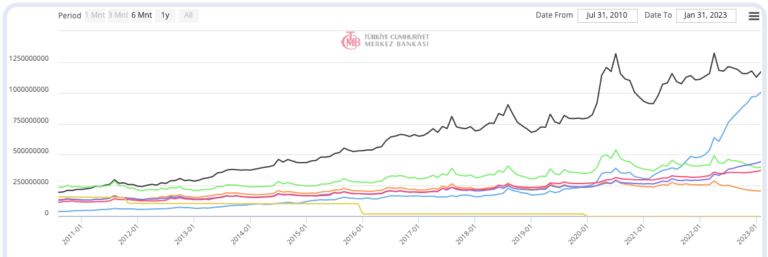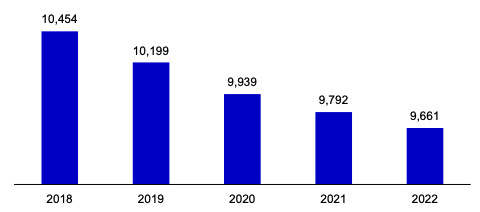Turkey: Cash after the Earthquakes
On February 6, two earthquakes of 7.8 and 7.5 magnitudes struck Turkey and Syria (see Map 1). Another 6.4-magnitude quake hit the region on February 21. The earthquakes killed over 44,000 people, left tens of thousands homeless, leveled buildings, and disrupted power, transportation, and communications.
Map 1. Middle East: Regions Affected by February 6, 2023 Earthquake

Source: DW (2023).
Turkey’s Banking Infrastructure: Repercussions
The earthquakes disrupted Turkey’s banking infrastructure.
- “In general, there is no gas, no water. Sometimes you find electricity in the houses, but none of the ATMs are working; we can’t withdraw any moneyFrom the Latin word moneta, nickname that was given by Romans to the goddess Juno because there was a minting workshop next to her temple. Money is any item that is generally accepted as payment for goods and services and repayment of debts, such as taxes, in a particular region, country or socio-economic context. Its onset dates back to the origins of humanity and its physical representation has taken on very varied forms until the appearance of metal coins. The banknote, a typical representati... More,” said Rami, a CARE Germany program officer in Gaziantep.
- “There are no banks, no ATMs left, everything’s gone, and only cashMoney in physical form such as banknotes and coins. More works. I called my childhood friend […] and asked him to find my sister and give her some cash. […] She was stuck for cash, but my friend reached her […]. He only had 5,000 [Turkish] lira [TRY, equivalent to €250] and I sent it to him straight away,” said Ali Atlia, a chef from Antakya who lives in Ireland.
- “I sent some money to a friend of mine and they don’t get it. It’s in their account, but there’s no money. I don’t know how they’re going to survive, but everybody is trying to understand each other, saying ‘OK, you can pay it later or give it later,’” said Mustafa Kutan, who moved in 2021 from Malatya to Canada.
- According to the DW and the AFP, some looters stole cash from banks and ATMs. In Kahramanmaraş, teams removing debris found a bank’s cash registerSee See-through register. More and ATMs and gave the funds to the police. A rescue team found USD2 million in cash in Gaziantep.
- The Banks Association of Türkiye (TBB) reported that 448 branches (out of 870 in the region) offered services, and 2,977 ATMs (out of 4,131 ATMs) were in working conditions as of February 17.
Turkey: Cash and its Infrastructure
Figures from the Central Bank of the Republic of Türkiye (CBRT) show that the currencyThe money used in a particular country at a particular time, like dollar, yen, euro, etc., consisting of banknotes and coins, that does not require endorsement as a medium of exchange. More issued has increased since 2019 (see Graph 1). Currency issues grew more quickly during the Covid-19 pandemic. Cash comprised 89% of retail transactions and 75% in value terms in 2020 (Çevik, Teber 2021).
Graph 1. Turkey: Currency Issued and Currency Outside Banks, 2010-2023 (TRY Thousand)

Note: currency issued in black; currency outside banks in blue. Source: CBRT Statistics: Money and Banking Statistics, CBRT Balance SheetA piece of paper or substrate of 800 mm by 700 mm, on which banknotes are printed. The “sheet to sheet” printing technique is the most widely used in printing of banknotes, but the roller printing technique also exists. More Data (2023).
The CBRT circulates banknotes via its 21 branches, two cash centers (affiliated with the Istanbul branch), and 16 banknoteA banknote (or ‘bill’ as it is often referred to in the US) is a type of negotiable promissory note, issued by a bank or other licensed authority, payable to the bearer on demand. More deposits. By denominationEach individual value in a series of banknotes or coins. More (see Graph 2 below), the TRY100 note (equivalent to USD5.31) is the most prevalent in the country, closely followed by the TRY200 note (equal to USD10.61) due to the country’s high inflation.
Graph 2. Turkey: Banknotes in Circulation by Denomination, 2010-2022 (Banknotes)

Note: TRY200 in blue, TRY100 in black, TRY50 in green, TRY20 in orange, TRY10 in purple, TRY5 in red, and other banknotes in yellow. Source: CBRT Statistics: PaymentA transfer of funds which discharges an obligation on the part of a payer vis-à-vis a payee. More Systems and Emission (2023).
Turkey’s banking infrastructure has recently diminished (see Graph 3). In 2022, Turkey had 9,661 deposit bank branches, 11.4 per 100,000 people (TBB 2022: iii, iv).
Graph 3. Turkey: Deposit Bank Branches, 2018-2022

Source: TBB Statistical Reports: Banks, Employees, and Branches (December 2022: iii).
Payments Sector: Responses
“The banking sector is committed to providing banking services in the earthquake zone.” – Banks Association of Türkiye (TBB)
- The Central Bank of the Republic of Türkiye (CBRT) offered financial relief to companies in the earthquake zone (February 6) and instructed banks not to charge fees for money transfers made to relief accounts (February 6).
- The Banking Regulation and Supervision Agency (BDDK) postponed exams for bank assistant auditors (February 6); offered debt relief for residents and companies, extended installment periods for credit card purchases (February 7); and promoted SMS donations to relief organizations (February 14).
- The Banks Association of Türkiye (TBB) eased debt repayment conditions for affected customers (February 6); waived all ATM fees (February 6), point-of-sale (POS) terminalA device allowing the use of payment cards at a physical (not virtual) point of sale. The payment information is captured either manually on paper vouchers or by electronic means. More fees, and service commissions (February 15); dispatched 352 trucks and vans with relief supplies (February 11); and established 16 temporary service points to meet customer’s demands (February 17).
- The Participation (Islamic) Banks Association of Türkiye (TKBB) offered joint ATM services for free to affected bank customers (February 6); enabled donations to relief organizations via SMS messages, banking apps, and websites (February 8); published a dashboard on bank branches and ATMs working conditions (February 12); and waived POSAbbreviation for “point of sale”. See Point-of-Sale terminal. More terminals usage fees throughout 2023 (February 16).
Cash Donations and Assistance Help the Most
- “The temptation is to give blankets and teddy bears and strollers and goods. But what the organizations on the ground most need is money, is cash, because they can buy locally. That can actually help communities recover, get markets going again,” said Samantha Power, administrator of the U.S. Agency for International Development (USAID).
- The USAID’s Center for International Disaster Information (CIDI) recommends giving “monetary donations to aid groups working on the ground” as “cash is fast and flexible, allowing professional aid groups to purchase exactly what is needed, when it is needed.”
- Asked whether people should send goods or cash, Ali Kiran, the president of the House of Turkey in San Diego, said, “Sending something from here to there will take time. […] The easiest way to reach them is via monetary donations, because money travels fastest.”
- The International Rescue Committee (IRC) will provide communities in northwestern Syria and Turkey with “cash, and essential items, such as household kits, dignity kits for women and girls, and hygiene supplies.” “Our teams will be providing cash assistanceThe term cash assistance refers to direct cash transfers to individuals, families and communities in need of humanitarian support in lieu of in-kind commodities or direct service delivery. The term can be used interchangeably with ‘cash-based interventions’ (CBI), ‘cash transfer programming’ (CTP), ‘cash and voucher assistance’ (CVA), and ‘cash-based programming (CBP)’. It does not include fund transfers from donors, payment of incentives to the staff of local authorities, paymen... More, rehabilitating health centers and providing protection,” said an IRC worker in Gaziantep.
Beware of Scams
Some scammers channel donations from TikTok and Twitter into PayPal accounts and cryptocurrency wallets.
- “They create fake disaster relief accounts that appear to be legitimate organizations or news outlets, but then drive funds to their own PayPal addresses,” said Ax Sharma, cyber security expert at Sonatype. PayPal has not operated in Turkey since 2016.
- “PayPal teams are always working diligently to scrutinize and ban accounts, particularly in the wake of events like the earthquake in Turkey and Syria, so that donations go to intended causes,” said a PayPal spokesperson.
- The CBRT issued a regulation against the use of crypto assets in payments in April 2021.
The U.S. Federal Trade Commission (FTC) urged vigilance against charity scams. The FTC advises not to give donations “in cash, by gift card, or by wiring money [… To] be safer, pay by credit card or check.”